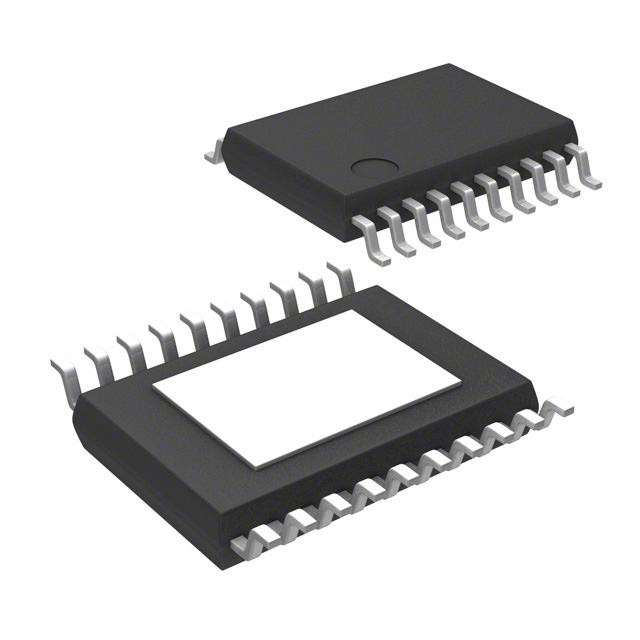Viz Specifikace pro podrobnosti o produktu.

LT3741EFE#TRPBF
Product Overview
- Category: Integrated Circuit (IC)
- Use: Power Management
- Characteristics: High Efficiency, Synchronous Step-Down DC/DC Converter
- Package: 28-Lead TSSOP
- Essence: Regulates voltage levels efficiently in power management applications
- Packaging/Quantity: Tape & Reel, 2500 units per reel
Specifications
- Input Voltage Range: 3.6V to 36V
- Output Voltage Range: 0.8V to 34V
- Switching Frequency: Up to 2MHz
- Maximum Output Current: 4A
- Efficiency: Up to 95%
- Operating Temperature Range: -40°C to 125°C
Detailed Pin Configuration
The LT3741EFE#TRPBF IC has a total of 28 pins. The pin configuration is as follows:
- VIN: Input Voltage
- SW: Switch Node Connection
- PGND: Power Ground
- AGND: Analog Ground
- FB: Feedback Voltage Input
- VCC: Internal Regulator Output
- SS: Soft-Start Control
- SYNC/MODE: External Clock Synchronization or Mode Selection
- RT/CLKOUT: Oscillator Resistor or Clock Output
- CLKIN: External Clock Input
- PGOOD: Power Good Indicator
- EN/UVLO: Enable or Undervoltage Lockout Control
- VREF: Reference Voltage Output
- COMP: Error Amplifier Output
- SS/TR/SSFB: Soft-Start, Tracking, or Soft-Start Feedback
- ITH: Current Sense Threshold
- BST: Bootstrap Capacitor Connection
- SW: Switch Node Connection
- PGND: Power Ground
- AGND: Analog Ground
- FB: Feedback Voltage Input
- VCC: Internal Regulator Output
- SS: Soft-Start Control
- SYNC/MODE: External Clock Synchronization or Mode Selection
- RT/CLKOUT: Oscillator Resistor or Clock Output
- CLKIN: External Clock Input
- PGOOD: Power Good Indicator
- EN/UVLO: Enable or Undervoltage Lockout Control
Functional Features
The LT3741EFE#TRPBF offers the following functional features:
- High efficiency synchronous step-down DC/DC converter
- Wide input voltage range for versatile applications
- Adjustable output voltage to meet specific requirements
- High switching frequency for compact designs
- Integrated power and analog ground for improved performance
- Soft-start control for smooth startup
- External clock synchronization option for precise timing
- Power good indicator for system monitoring
- Enable and undervoltage lockout control for enhanced safety
Advantages and Disadvantages
Advantages of the LT3741EFE#TRPBF include:
- High efficiency operation, reducing power losses
- Wide input voltage range allows for flexibility in various applications
- Compact package size for space-constrained designs
- Adjustable output voltage meets specific requirements
- Integrated power and analog ground improve performance
Disadvantages of the LT3741EFE#TRPBF include:
- Limited maximum output current of 4A
- Requires external components for complete functionality
- Relatively high operating temperature range may require additional cooling measures
Working Principles
The LT3741EFE#TRPBF is a synchronous step-down DC/DC converter that regulates voltage levels efficiently. It operates by converting a higher input voltage to a lower output voltage using a switching regulator topology. The IC utilizes high-frequency switching to minimize power losses and maximize efficiency.
The input voltage is connected to the VIN pin, and the output voltage is obtained from the SW pin. The feedback voltage (FB) pin is used to set the desired output voltage level. The LT3741EFE#TRPBF employs an internal regulator (VCC) to power its internal circuitry.
By controlling the switching frequency and duty cycle, the IC adjusts the output voltage according to the feedback signal. Soft-start control ensures a gradual increase in output voltage during startup, preventing excessive current surges.
Detailed Application Field Plans
The LT3741EFE#TRPBF is suitable for various power management applications, including:
- Industrial equipment
- Automotive systems
- Telecommunications infrastructure
- Distributed power supplies
- Battery-powered devices
- LED lighting systems
- Renewable energy systems
Its wide input voltage range, adjustable output voltage, and high efficiency make it versatile for different application scenarios.
Detailed and Complete Alternative Models
- LT3741A: Similar specifications with enhanced thermal performance
- LT3741B
Seznam 10 běžných otázek a odpovědí souvisejících s aplikací LT3741EFE#TRPBF v technických řešeních
Sure! Here are 10 common questions and answers related to the application of LT3741EFE#TRPBF in technical solutions:
Q1: What is LT3741EFE#TRPBF? A1: LT3741EFE#TRPBF is a specific model number of a power management integrated circuit (IC) manufactured by Linear Technology (now part of Analog Devices). It is designed for high voltage, high power applications.
Q2: What are the key features of LT3741EFE#TRPBF? A2: Some key features of LT3741EFE#TRPBF include wide input voltage range, high efficiency, programmable switching frequency, adjustable current limit, and various protection features.
Q3: What are the typical applications of LT3741EFE#TRPBF? A3: LT3741EFE#TRPBF is commonly used in applications such as LED lighting, automotive lighting, industrial equipment, and other high power systems that require efficient power management.
Q4: What is the maximum input voltage supported by LT3741EFE#TRPBF? A4: The maximum input voltage supported by LT3741EFE#TRPBF is typically around 100V, but it can vary depending on the specific operating conditions and external components used.
Q5: How does LT3741EFE#TRPBF achieve high efficiency? A5: LT3741EFE#TRPBF achieves high efficiency through its synchronous rectification and low dropout voltage operation. It also incorporates various control techniques to optimize power conversion efficiency.
Q6: Can LT3741EFE#TRPBF be used in both step-up (boost) and step-down (buck) configurations? A6: Yes, LT3741EFE#TRPBF can be used in both step-up and step-down configurations, making it versatile for various power management applications.
Q7: What is the maximum output current that LT3741EFE#TRPBF can handle? A7: The maximum output current that LT3741EFE#TRPBF can handle depends on the specific operating conditions and thermal considerations. It is typically in the range of several amps.
Q8: Does LT3741EFE#TRPBF have any built-in protection features? A8: Yes, LT3741EFE#TRPBF incorporates various protection features such as overvoltage protection, overcurrent protection, and thermal shutdown to ensure safe operation.
Q9: Can LT3741EFE#TRPBF be controlled using an external microcontroller? A9: Yes, LT3741EFE#TRPBF can be controlled using an external microcontroller through its enable pin and other control inputs. This allows for more advanced control and monitoring capabilities.
Q10: Are there any evaluation boards or reference designs available for LT3741EFE#TRPBF? A10: Yes, Analog Devices provides evaluation boards and reference designs for LT3741EFE#TRPBF, which can help users quickly prototype and implement their power management solutions.
Please note that the answers provided here are general and may vary depending on the specific datasheet and application requirements.

